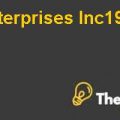
QUESTION 1: Explain and discuss each type of foreign exchange exposure (translation, transaction and economic/competitive) that General Motors face by providing data and information from the case study, and by defining the each type of foreign exchange exposure.
Translational Risk:
Translational risks are defined as the risks associated with the assets and liabilities of an organization in other parts of the world and any changes in the currency would change the value of those assets and liabilities. In these assets, liabilities, revenues, and equity that are in other countries, if currency value decreases it would decrease the value of an asset, equity that would generates low revenues, meanwhile, the liabilities would also decrease, hence, translation risk would be reduced to the extent of the value of liabilities in comparison of the risk of revenues and assets. However, translation risk is not an economic risk instead it is a risk that affects the balance sheet values when the balance sheet of subsidiaries that are operating in other countries, are translated into parent company currency for consolidation of financial statements.
General Motors’ subsidiary, GM Canada, whose base currency is Canadian dollars, has assets that include cash, receivables, deferred income taxes and some pension assets totaling to C$ 2,597/-, meanwhile, GM Canada also owns liabilities of C$ 4,739/-. Therefore, when General Motors will consolidate the assets and liabilities of GM Canada then this will involve the translation of GM Canada’s assets and liabilities and assets into USD which will expose the value of these assets and liabilities to foreign exchange exposure. However, General Motors is exposed to a net translation exposure for a liability of C$ 2,143/-.
Transactional Risk:
For an organization that has operations in different countries and generating revenues in different currencies, it is exposed to transaction risks where transaction risks, identifies as the risk associated with the transactions between two different currencies. This risk becomes more risky when any currency involved in the transaction is devalued or appreciated against the company’s home currency and when it occurs than it affects the company’s liquidity position in such a way in which company has to pay more than the decided amount to complete the transactions.
In this the fluctuation in the exchange rates has lots of effects and for the General Motors this risk is as high as its operations are in various parts of the world in various currencies and any fluctuation in these operative currencies would impact its liquidity to pay off the settlement amounts with respect to the each transaction. However, the transaction risk arises from the real transactions that involves debt raised and account receivables created in currencies other than the base currency of the parent company. General Motors is exposed to the risk arising from the transactions in Canadian dollars that leads to certain inflows of C$11,613/- and outflows of C$ 13,294/- as shown in exhibit 9, hence, General Motors is exposed to a net transaction exposure that requires an outflow of C$ 1,682/-.
Economic/Competitive Exposure:
Economic or competitive exposure arises as a result of changes in the exchange rate of the currency that is the base currency of our competitors and the economic exposure is not a risk that will be led by the inflows or outflows of General Motors. However, this risk exposes the competitive position of competitors at risk just because of the devaluation in the currency of one competitor’s base currency, which leads to the reduction in cost of production because the value of export will be converted into local currency and devalued currency will result in higher amount being converted into the local currency. Therefore, the producer of goods reduces its selling price equal to the increase in local currency received on conversion of foreign revenues in this way the devalued home currency allows the producer to offer its goods at a lower price in the international market than its competitors’ price. Meanwhile, the lower price leads to the decline in the competitors’ market shares as well. Hence, the competitive exposure indirectly arises as a result of competitive interactions with the competitors whose base currency is other than the base currency of the parent company.
However, at General Motors, the company is exposed to the economic exposure due to the devaluation of the Yen, because some of its competitors operates from Japan, where the base currency is the Yen, hence, a devalued Yen would allow the Japanese producers of automobiles to lower down their prices and on export vehicles that would help them gain market shares and as a result the General Motors’ market shares would be reduced and its profit margins would be reduced. Since, General Motor’s annual sales in United Sales accounts for 72% of its total global sales that would be around $133 million in the year 2000 and in case of economic exposure..............
This is just a sample partial case solution. Please place the order on the website to order your own originally done case solution.











